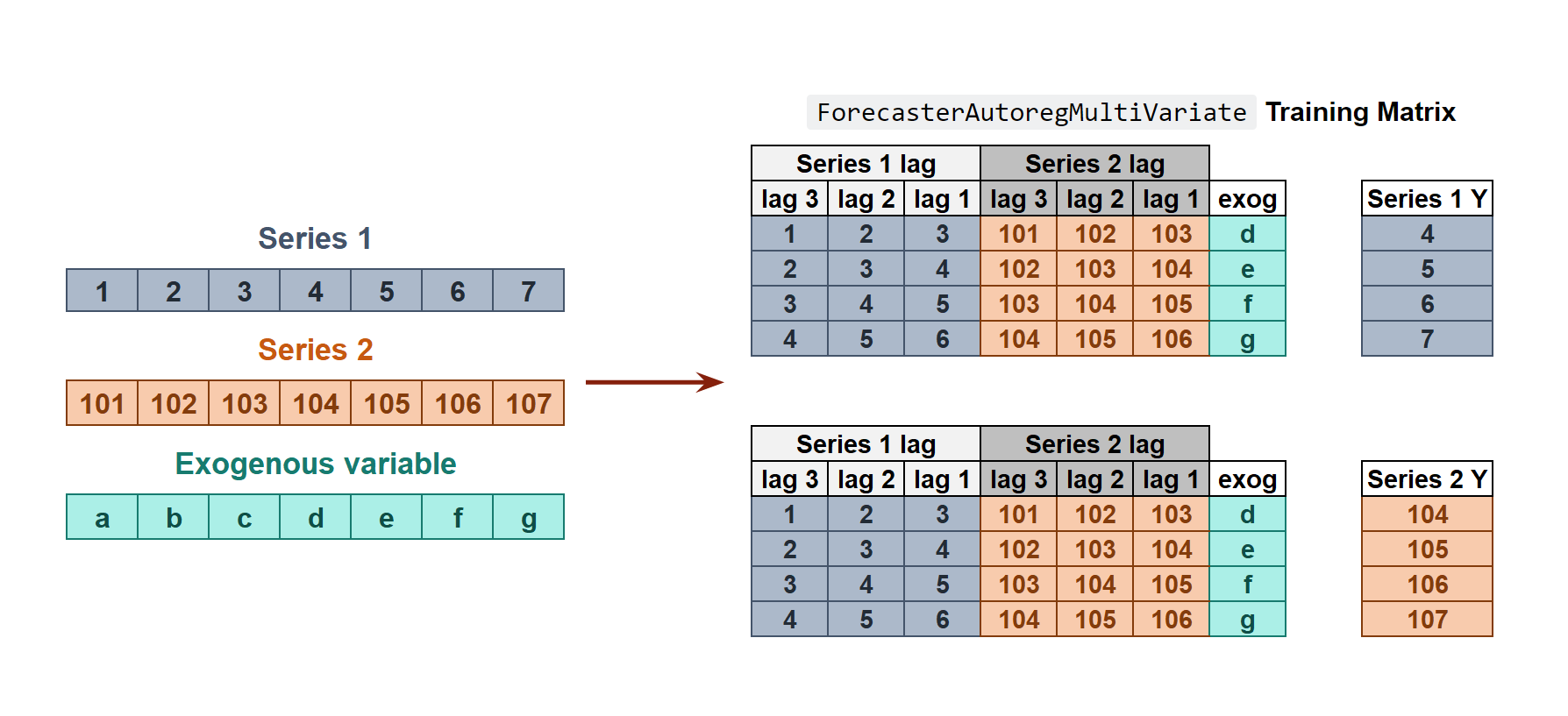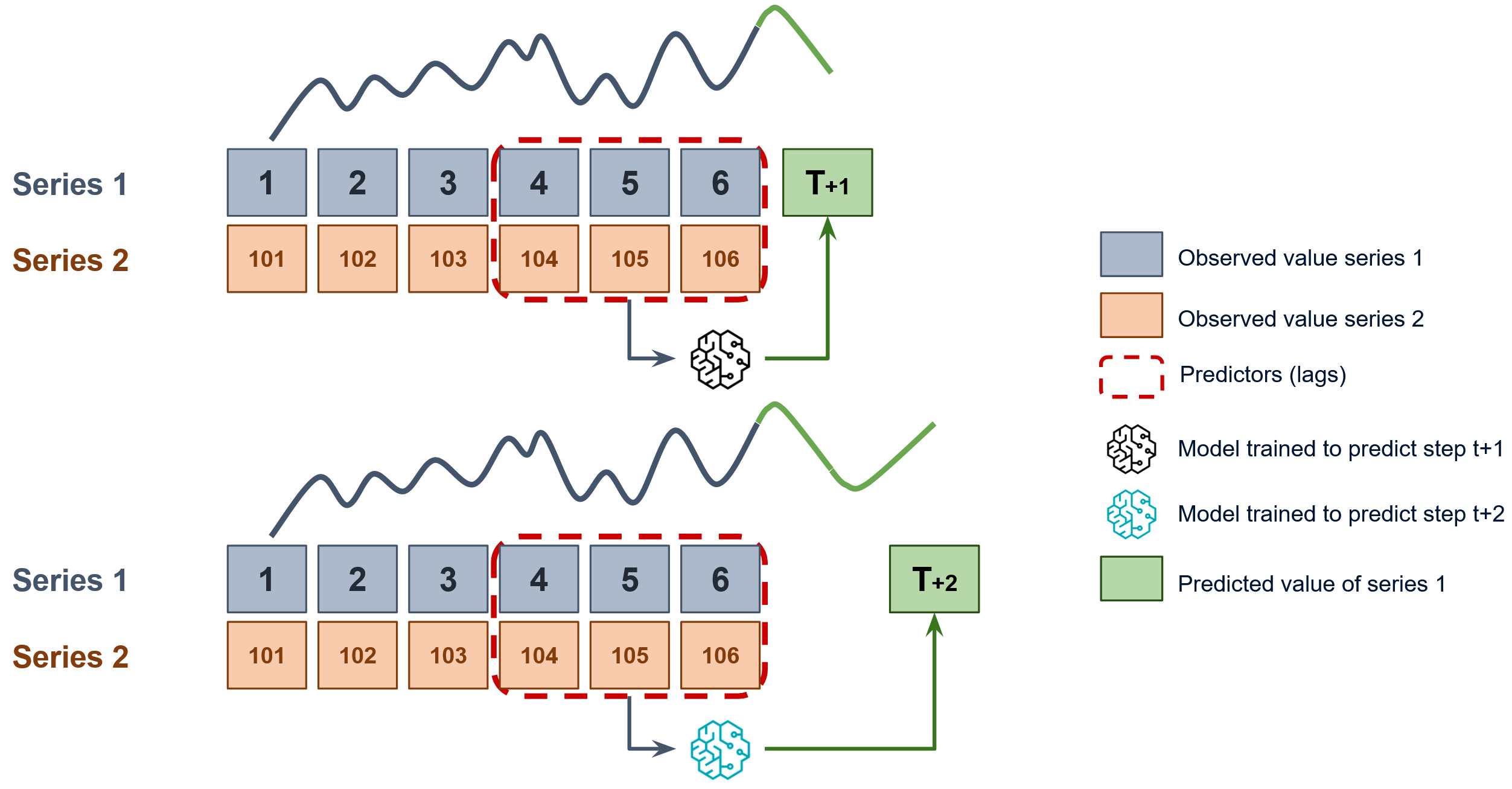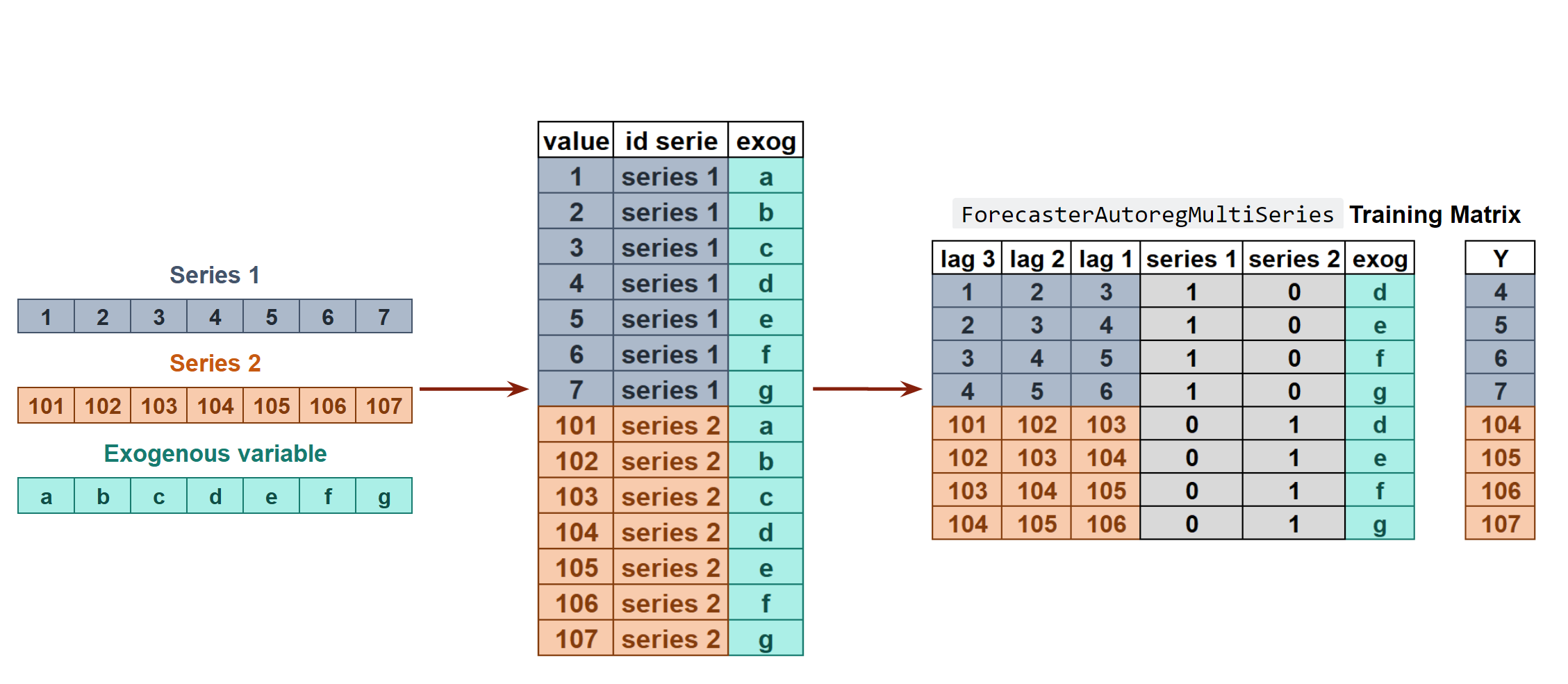Multivariate forecasting¶
In univariate time series forecasting, a single time series is modeled as a linear or nonlinear combination of its lags. That is, the past values of the series are used to forecast its future. In multi-series forecasting, two or more time series are modeled together using a single model. Two strategies can be distinguished:
Multivariate time series
All series are modeled considering that each time series depends not only on its past values but also on the past values of the other series. The forecaster is expected not only to learn the information of each series separately but also to relate them. For example, the measurements made by all the sensors (flow, temperature, pressure...) installed on an industrial machine such as a compressor.

Since as many training matrices are created as there are series in the dataset, it must be decided on which level the forecasting will be performed.
To predict the next n steps a model is trained for each step to be predicted, the selected level in the figure is Series 1. This strategy is of the type direct multi-step forecasting.

No multivariate time series
A single model is trained, but each time series remains independent of the others. In other words, the past values of one series are not used as predictors of other series. Why is it useful then to model everything together? Although the series do not depend on each other, they may follow the same intrinsic pattern regarding their past and future values. For example, in the same store, the sales of products A and B may not be related, but they follow the same dynamics, that of the store. No multivariate time series user guide.

Note
ForecasterAutoregMultiVariate class covers the use case of Multivariate time series.
Libraries¶
# Libraries
# ==============================================================================
import numpy as np
import pandas as pd
import matplotlib.pyplot as plt
from sklearn.preprocessing import StandardScaler
from sklearn.linear_model import Ridge
from sklearn.ensemble import RandomForestRegressor
from sklearn.metrics import mean_absolute_error
from skforecast.ForecasterAutoregMultiVariate import ForecasterAutoregMultiVariate
from skforecast.model_selection_multiseries import backtesting_forecaster_multiseries
from skforecast.model_selection_multiseries import grid_search_forecaster_multiseries
from skforecast.model_selection_multiseries import random_search_forecaster_multiseries
Data¶
# Data download
# ==============================================================================
url = ('https://raw.githubusercontent.com/JoaquinAmatRodrigo/skforecast/master/' +
'data/guangyuan_air_pollution.csv')
data = pd.read_csv(url, sep=',')
# Data preparation
# ==============================================================================
data['date'] = pd.to_datetime(data['date'], format='%Y-%m-%d')
data = data.set_index('date')
data = data.asfreq('D')
data = data.sort_index()
data = data[['CO', 'SO2', 'PM2.5']]
data.head()
| CO | SO2 | PM2.5 | |
|---|---|---|---|
| date | |||
| 2013-03-01 | 9600.0 | 204.0 | 181.0 |
| 2013-03-02 | 20198.0 | 674.0 | 633.0 |
| 2013-03-03 | 47195.0 | 1661.0 | 1956.0 |
| 2013-03-04 | 15000.0 | 485.0 | 438.0 |
| 2013-03-05 | 59594.0 | 2001.0 | 3388.0 |
# Split data into train-val-test
# ==============================================================================
end_train = '2016-05-31 23:59:00'
data_train = data.loc[:end_train, :].copy()
data_test = data.loc[end_train:, :].copy()
print(f"Train dates : {data_train.index.min()} --- {data_train.index.max()} (n={len(data_train)})")
print(f"Test dates : {data_test.index.min()} --- {data_test.index.max()} (n={len(data_test)})")
Train dates : 2013-03-01 00:00:00 --- 2016-05-31 00:00:00 (n=1188) Test dates : 2016-06-01 00:00:00 --- 2017-02-28 00:00:00 (n=273)
# Plot time series
# ==============================================================================
fig, axes = plt.subplots(nrows=3, ncols=1, figsize=(10, 6), sharex=True)
data_train['CO'].plot(label='train', ax=axes[0])
data_test['CO'].plot(label='test', ax=axes[0])
axes[0].set_xlabel('')
axes[0].set_ylabel('Concentration (ug/m^3)')
axes[0].set_title('CO')
axes[0].legend()
data_train['SO2'].plot(label='train', ax=axes[1])
data_test['SO2'].plot(label='test', ax=axes[1])
axes[1].set_xlabel('')
axes[1].set_ylabel('Concentration (ug/m^3)')
axes[1].set_title('SO2')
data_train['PM2.5'].plot(label='train', ax=axes[2])
data_test['PM2.5'].plot(label='test', ax=axes[2])
axes[2].set_xlabel('')
axes[2].set_ylabel('Concentration (ug/m^3)')
axes[2].set_title('PM2.5')
fig.tight_layout()
plt.show();
Train and predict ForecasterAutoregMultiVariate¶
When initializing the forecaster, the level to be predicted and the maximum number of steps must be indicated since a different model will be created for each step.
# Create and fit forecaster MultiVariate
# ==============================================================================
forecaster = ForecasterAutoregMultiVariate(
regressor = Ridge(random_state=123),
level = 'CO',
lags = 7,
steps = 7,
transformer_series = None,
transformer_exog = None,
weight_func = None
)
forecaster.fit(series=data_train)
forecaster
=============================
ForecasterAutoregMultiVariate
=============================
Regressor: Ridge(random_state=123)
Lags: [1 2 3 4 5 6 7]
Transformer for series: None
Transformer for exog: None
Window size: 7
Multivariate series (names): ['CO', 'SO2', 'PM2.5']
Maximum steps predicted: 7
Weight function included: False
Exogenous included: False
Type of exogenous variable: None
Exogenous variables names: None
Training range: [Timestamp('2013-03-01 00:00:00'), Timestamp('2016-05-31 00:00:00')]
Training index type: DatetimeIndex
Training index frequency: D
Regressor parameters: {'alpha': 1.0, 'copy_X': True, 'fit_intercept': True, 'max_iter': None, 'normalize': 'deprecated', 'positive': False, 'random_state': 123, 'solver': 'auto', 'tol': 0.001}
Creation date: 2022-12-01 10:33:29
Last fit date: 2022-12-01 10:33:29
Skforecast version: 0.6.0
Python version: 3.9.13
When predicting, the value of steps must be less than or equal to the value of steps defined when initializing the forecaster. Starts at 1.
If
intonly steps within the range of 1 to int are predicted.If
listof ints. Only the steps contained in the list are predicted.If
Noneas many steps are predicted as were defined at initialization.
# Predict MultiVariate
# ==============================================================================
predictions = forecaster.predict()
print('As many steps are predicted as have been defined in the initialization.')
display(predictions)
predictions = forecaster.predict(steps=[1, 5])
print('')
print('Only the steps contained in the list are predicted.')
display(predictions)
As many steps are predicted as have been defined in the initialization.
| CO | |
|---|---|
| 2016-06-01 | 20244.442039 |
| 2016-06-02 | 23307.697174 |
| 2016-06-03 | 22487.345075 |
| 2016-06-04 | 23111.643246 |
| 2016-06-05 | 24686.327128 |
| 2016-06-06 | 24023.210710 |
| 2016-06-07 | 24015.607873 |
Only the steps contained in the list are predicted.
| CO | |
|---|---|
| 2016-06-01 | 20244.442039 |
| 2016-06-05 | 24686.327128 |
Backtesting MultiVariate¶
See the backtesting user guide to learn more about backtesting.
# Backtesting MultiVariate
# ==============================================================================
metrics_levels, backtest_predictions = backtesting_forecaster_multiseries(
forecaster = forecaster,
series = data,
steps = 7,
metric = 'mean_absolute_error',
initial_train_size = len(data_train),
refit = False,
fixed_train_size = False,
verbose = False
)
print("Backtest metrics")
display(metrics_levels)
print("")
print("Backtest predictions")
backtest_predictions.head(4)
Backtest metrics
| levels | mean_absolute_error | |
|---|---|---|
| 0 | CO | 14931.121425 |
Backtest predictions
| CO | |
|---|---|
| 2016-06-01 | 20244.442039 |
| 2016-06-02 | 23307.697174 |
| 2016-06-03 | 22487.345075 |
| 2016-06-04 | 23111.643246 |
Hyperparameter tuning and lags selection MultiVariate¶
Functions grid_search_forecaster_multiseries and random_search_forecaster_multiseries in the module model_selection_multiseries allow for lag and hyperparameter optimization. The optimization is performed in the same way as in the other forecasters, see the user guide here.
The following example shows how to use random_search_forecaster_multiseries to find the best lags and model hyperparameters for all time series:
# Create and forecaster MultiVariate
# ==============================================================================
forecaster = ForecasterAutoregMultiVariate(
regressor = RandomForestRegressor(random_state=123),
level = 'CO',
lags = 7,
steps = 7,
transformer_series = None,
transformer_exog = None,
weight_func = None
)
# Random search MultiVariate
# ==============================================================================
lags_grid = [7, 14]
param_distributions = {'n_estimators': np.arange(start=10, stop=20, step=1, dtype=int),
'max_depth': np.arange(start=3, stop=6, step=1, dtype=int)}
results = random_search_forecaster_multiseries(
forecaster = forecaster,
series = data,
exog = None,
lags_grid = lags_grid,
param_distributions = param_distributions,
steps = 7,
metric = 'mean_absolute_error',
initial_train_size = len(data_train),
refit = False,
fixed_train_size = False,
n_iter = 5,
return_best = False,
verbose = False
)
results
10 models compared for 1 level(s). Number of iterations: 10.
loop lags_grid: 100%|███████████████████████████████████████| 2/2 [00:07<00:00, 3.62s/it]
| levels | lags | params | mean_absolute_error | n_estimators | max_depth | |
|---|---|---|---|---|---|---|
| 7 | [CO] | [1, 2, 3, 4, 5, 6, 7, 8, 9, 10, 11, 12, 13, 14] | {'n_estimators': 15, 'max_depth': 3} | 15991.360494 | 15 | 3 |
| 5 | [CO] | [1, 2, 3, 4, 5, 6, 7, 8, 9, 10, 11, 12, 13, 14] | {'n_estimators': 17, 'max_depth': 3} | 16001.390244 | 17 | 3 |
| 9 | [CO] | [1, 2, 3, 4, 5, 6, 7, 8, 9, 10, 11, 12, 13, 14] | {'n_estimators': 18, 'max_depth': 3} | 16058.419766 | 18 | 3 |
| 8 | [CO] | [1, 2, 3, 4, 5, 6, 7, 8, 9, 10, 11, 12, 13, 14] | {'n_estimators': 16, 'max_depth': 5} | 16160.441414 | 16 | 5 |
| 6 | [CO] | [1, 2, 3, 4, 5, 6, 7, 8, 9, 10, 11, 12, 13, 14] | {'n_estimators': 19, 'max_depth': 5} | 16192.047506 | 19 | 5 |
| 3 | [CO] | [1, 2, 3, 4, 5, 6, 7] | {'n_estimators': 16, 'max_depth': 5} | 16195.444749 | 16 | 5 |
| 4 | [CO] | [1, 2, 3, 4, 5, 6, 7] | {'n_estimators': 18, 'max_depth': 3} | 16203.381611 | 18 | 3 |
| 1 | [CO] | [1, 2, 3, 4, 5, 6, 7] | {'n_estimators': 19, 'max_depth': 5} | 16269.039511 | 19 | 5 |
| 0 | [CO] | [1, 2, 3, 4, 5, 6, 7] | {'n_estimators': 17, 'max_depth': 3} | 16303.094588 | 17 | 3 |
| 2 | [CO] | [1, 2, 3, 4, 5, 6, 7] | {'n_estimators': 15, 'max_depth': 3} | 16354.631284 | 15 | 3 |
Custom lags in MultiVariate¶
If a dict is passed to the lags argument, it allows to set different lags for each of the series.
# Create and fit forecaster MultiVariate Custom lags
# ==============================================================================
forecaster = ForecasterAutoregMultiVariate(
regressor = Ridge(random_state=123),
level = 'CO',
lags = {'CO': 7, 'SO2': [1, 7], 'PM2.5': 2},
steps = 7,
transformer_series = None,
transformer_exog = None,
weight_func = None
)
forecaster.fit(series=data_train)
# Predict MultiVariate
# ==============================================================================
predictions = forecaster.predict(steps=7)
display(predictions)
| CO | |
|---|---|
| 2016-06-01 | 19421.982426 |
| 2016-06-02 | 21856.950600 |
| 2016-06-03 | 21910.011418 |
| 2016-06-04 | 23197.353798 |
| 2016-06-05 | 23294.891733 |
| 2016-06-06 | 22478.158677 |
| 2016-06-07 | 23393.641623 |
# Extract training matrix
# ==============================================================================
X, y = forecaster.create_train_X_y(series=data_train)
# X and y to train model for step 1
X_1, y_1 = forecaster.filter_train_X_y_for_step(
step = 1,
X_train = X,
y_train = y,
)
X_1.head(4)
| CO_lag_1 | CO_lag_2 | CO_lag_3 | CO_lag_4 | CO_lag_5 | CO_lag_6 | CO_lag_7 | SO2_lag_1 | SO2_lag_7 | PM2.5_lag_1 | PM2.5_lag_2 | |
|---|---|---|---|---|---|---|---|---|---|---|---|
| date | |||||||||||
| 2013-03-14 | 94792.0 | 81291.0 | 59594.0 | 15000.0 | 47195.0 | 20198.0 | 9600.0 | 2369.0000 | 204.0 | 5952.0 | 4934.0 |
| 2013-03-15 | 78194.0 | 94792.0 | 81291.0 | 59594.0 | 15000.0 | 47195.0 | 20198.0 | 1535.5424 | 674.0 | 5039.0 | 5952.0 |
| 2013-03-16 | 24596.0 | 78194.0 | 94792.0 | 81291.0 | 59594.0 | 15000.0 | 47195.0 | 881.0000 | 1661.0 | 1242.0 | 5039.0 |
| 2013-03-17 | 17600.0 | 24596.0 | 78194.0 | 94792.0 | 81291.0 | 59594.0 | 15000.0 | 553.0000 | 485.0 | 818.0 | 1242.0 |
Weights in MultiVariate¶
The weights are used to control the influence that each observation has on the training of the model.
Learn more about weighted time series forecasting with skforecast.
# Weights in MultiVariate
# ==============================================================================
def custom_weights(index):
"""
Return 0 if index is between '2013-01-01' and '2013-01-31', 1 otherwise.
"""
weights = np.where(
(index >= '2013-01-01') & (index <= '2013-01-31'),
0,
1
)
return weights
forecaster = ForecasterAutoregMultiVariate(
regressor = Ridge(random_state=123),
level = 'CO',
lags = 7,
steps = 7,
transformer_series = None,
transformer_exog = None,
weight_func = custom_weights
)
forecaster.fit(series=data_train)
forecaster.predict(steps=7).head(3)
| CO | |
|---|---|
| 2016-06-01 | 20244.442039 |
| 2016-06-02 | 23307.697174 |
| 2016-06-03 | 22487.345075 |
Warning
Theweight_func argument will be ignored if the regressor does not accept sample_weight in its fit method.
The source code of the weight_func added to the forecaster is stored in the argument source_code_weight_func.
print(forecaster.source_code_weight_func)
def custom_weights(index):
"""
Return 0 if index is between '2013-01-01' and '2013-01-31', 1 otherwise.
"""
weights = np.where(
(index >= '2013-01-01') & (index <= '2013-01-31'),
0,
1
)
return weights
Scikit-learn transformers in MultiVariate¶
Learn more about using scikit-learn transformers with skforecast.
- If
transformer_seriesis atransformerthe same transformation will be applied to all series. - If
transformer_seriesis adicta different transformation can be set for each series. Series not present in the dict will not have any transformation applied to them.
forecaster = ForecasterAutoregMultiVariate(
regressor = Ridge(random_state=123),
level = 'CO',
lags = 7,
steps = 7,
transformer_series = {'CO': StandardScaler(), 'SO2': StandardScaler()},
transformer_exog = None,
weight_func = None,
)
forecaster.fit(series=data_train)
forecaster
c:\Users\jaesc2\Miniconda3\envs\skforecast\lib\site-packages\skforecast\ForecasterAutoregMultiVariate\ForecasterAutoregMultiVariate.py:430: UserWarning: {'PM2.5'} not present in `transformer_series`. No transformation is applied to these series.
warnings.warn(
=============================
ForecasterAutoregMultiVariate
=============================
Regressor: Ridge(random_state=123)
Lags: [1 2 3 4 5 6 7]
Transformer for series: {'CO': StandardScaler(), 'SO2': StandardScaler()}
Transformer for exog: None
Window size: 7
Multivariate series (names): ['CO', 'SO2', 'PM2.5']
Maximum steps predicted: 7
Weight function included: False
Exogenous included: False
Type of exogenous variable: None
Exogenous variables names: None
Training range: [Timestamp('2013-03-01 00:00:00'), Timestamp('2016-05-31 00:00:00')]
Training index type: DatetimeIndex
Training index frequency: D
Regressor parameters: {'alpha': 1.0, 'copy_X': True, 'fit_intercept': True, 'max_iter': None, 'normalize': 'deprecated', 'positive': False, 'random_state': 123, 'solver': 'auto', 'tol': 0.001}
Creation date: 2022-12-01 10:33:37
Last fit date: 2022-12-01 10:33:37
Skforecast version: 0.6.0
Python version: 3.9.13
Compare multiple metrics¶
All three functions (backtesting_forecaster_multiseries, grid_search_forecaster_multiseries, and random_search_forecaster_multiseries) allow the calculation of multiple metrics for each forecaster configuration if a list is provided. This list may include custom metrics and the best model selection is done based on the first metric of the list.
# Grid search MultiVariate with multiple metrics
# ==============================================================================
forecaster = ForecasterAutoregMultiVariate(
regressor = Ridge(random_state=123),
level = 'CO',
lags = 7,
steps = 7
)
def custom_metric(y_true, y_pred):
"""
Calculate the mean absolute error using only the predicted values of the last
3 months of the year.
"""
mask = y_true.index.month.isin([10, 11, 12])
metric = mean_absolute_error(y_true[mask], y_pred[mask])
return metric
lags_grid = [7, 14]
param_grid = {'alpha': [0.01, 0.1, 1]}
results = grid_search_forecaster_multiseries(
forecaster = forecaster,
series = data,
exog = None,
steps = 7,
metric = [mean_absolute_error, custom_metric, 'mean_squared_error'],
lags_grid = lags_grid,
param_grid = param_grid,
initial_train_size = len(data_train),
refit = False,
fixed_train_size = False,
return_best = True,
verbose = False
)
results
6 models compared for 1 level(s). Number of iterations: 6.
loop lags_grid: 100%|███████████████████████████████████████| 2/2 [00:00<00:00, 6.45it/s]
`Forecaster` refitted using the best-found lags and parameters, and the whole data set:
Lags: [1 2 3 4 5 6 7]
Parameters: {'alpha': 1}
Backtesting metric: 14931.121425356867
Levels: ['CO']
| levels | lags | params | mean_absolute_error | custom_metric | mean_squared_error | alpha | |
|---|---|---|---|---|---|---|---|
| 2 | [CO] | [1, 2, 3, 4, 5, 6, 7] | {'alpha': 1} | 14931.121425 | 21210.876663 | 5.519094e+08 | 1.00 |
| 1 | [CO] | [1, 2, 3, 4, 5, 6, 7] | {'alpha': 0.1} | 14931.121426 | 21210.876659 | 5.519094e+08 | 0.10 |
| 0 | [CO] | [1, 2, 3, 4, 5, 6, 7] | {'alpha': 0.01} | 14931.121426 | 21210.876659 | 5.519094e+08 | 0.01 |
| 5 | [CO] | [1, 2, 3, 4, 5, 6, 7, 8, 9, 10, 11, 12, 13, 14] | {'alpha': 1} | 15019.782237 | 20996.998181 | 5.649121e+08 | 1.00 |
| 4 | [CO] | [1, 2, 3, 4, 5, 6, 7, 8, 9, 10, 11, 12, 13, 14] | {'alpha': 0.1} | 15019.782238 | 20996.998178 | 5.649121e+08 | 0.10 |
| 3 | [CO] | [1, 2, 3, 4, 5, 6, 7, 8, 9, 10, 11, 12, 13, 14] | {'alpha': 0.01} | 15019.782238 | 20996.998178 | 5.649121e+08 | 0.01 |
Feature importance¶
Since ForecasterAutoregMultiVariate fits one model per step, it is necessary to specify from which model retrieves its feature importance.
forecaster.get_feature_importance(step=1)
| feature | importance | |
|---|---|---|
| 0 | CO_lag_1 | 0.655461 |
| 1 | CO_lag_2 | -0.072108 |
| 2 | CO_lag_3 | 0.097851 |
| 3 | CO_lag_4 | 0.055877 |
| 4 | CO_lag_5 | 0.067536 |
| 5 | CO_lag_6 | -0.122215 |
| 6 | CO_lag_7 | 0.115945 |
| 7 | SO2_lag_1 | 5.336658 |
| 8 | SO2_lag_2 | -1.074241 |
| 9 | SO2_lag_3 | -3.647177 |
| 10 | SO2_lag_4 | 0.020614 |
| 11 | SO2_lag_5 | 1.483432 |
| 12 | SO2_lag_6 | 2.971133 |
| 13 | SO2_lag_7 | -1.764458 |
| 14 | PM2.5_lag_1 | -1.000016 |
| 15 | PM2.5_lag_2 | -0.902531 |
| 16 | PM2.5_lag_3 | 0.373182 |
| 17 | PM2.5_lag_4 | -0.767187 |
| 18 | PM2.5_lag_5 | -0.828407 |
| 19 | PM2.5_lag_6 | 0.546431 |
| 20 | PM2.5_lag_7 | -0.401235 |
Extract training matrix¶
Two steps are needed. One to create the whole training matrix and a second one to subset the data needed for each model (step).
# Extract training matrix
# ==============================================================================
X, y = forecaster.create_train_X_y(series=data_train)
# X and y to train model for step 1
X_1, y_1 = forecaster.filter_train_X_y_for_step(
step = 1,
X_train = X,
y_train = y,
)
X_1.head(4)
| CO_lag_1 | CO_lag_2 | CO_lag_3 | CO_lag_4 | CO_lag_5 | CO_lag_6 | CO_lag_7 | SO2_lag_1 | SO2_lag_2 | SO2_lag_3 | ... | SO2_lag_5 | SO2_lag_6 | SO2_lag_7 | PM2.5_lag_1 | PM2.5_lag_2 | PM2.5_lag_3 | PM2.5_lag_4 | PM2.5_lag_5 | PM2.5_lag_6 | PM2.5_lag_7 | |
|---|---|---|---|---|---|---|---|---|---|---|---|---|---|---|---|---|---|---|---|---|---|
| date | |||||||||||||||||||||
| 2013-03-14 | 94792.0 | 81291.0 | 59594.0 | 15000.0 | 47195.0 | 20198.0 | 9600.0 | 2369.0000 | 3052.0000 | 2001.0000 | ... | 1661.0 | 674.0 | 204.0 | 5952.0 | 4934.0 | 3388.0 | 438.0 | 1956.0 | 633.0 | 181.0 |
| 2013-03-15 | 78194.0 | 94792.0 | 81291.0 | 59594.0 | 15000.0 | 47195.0 | 20198.0 | 1535.5424 | 2369.0000 | 3052.0000 | ... | 485.0 | 1661.0 | 674.0 | 5039.0 | 5952.0 | 4934.0 | 3388.0 | 438.0 | 1956.0 | 633.0 |
| 2013-03-16 | 24596.0 | 78194.0 | 94792.0 | 81291.0 | 59594.0 | 15000.0 | 47195.0 | 881.0000 | 1535.5424 | 2369.0000 | ... | 2001.0 | 485.0 | 1661.0 | 1242.0 | 5039.0 | 5952.0 | 4934.0 | 3388.0 | 438.0 | 1956.0 |
| 2013-03-17 | 17600.0 | 24596.0 | 78194.0 | 94792.0 | 81291.0 | 59594.0 | 15000.0 | 553.0000 | 881.0000 | 1535.5424 | ... | 3052.0 | 2001.0 | 485.0 | 818.0 | 1242.0 | 5039.0 | 5952.0 | 4934.0 | 3388.0 | 438.0 |
4 rows × 21 columns
y_1.head(4)
date 2013-03-14 78194.0 2013-03-15 24596.0 2013-03-16 17600.0 2013-03-17 40794.0 Freq: D, Name: CO_step_1, dtype: float64
Warning
bayesian_search_forecaster_multiseries will be released in a future version of Skforecast
Stay tuned!
%%html
<style>
.jupyter-wrapper .jp-CodeCell .jp-Cell-inputWrapper .jp-InputPrompt {display: none;}
</style>